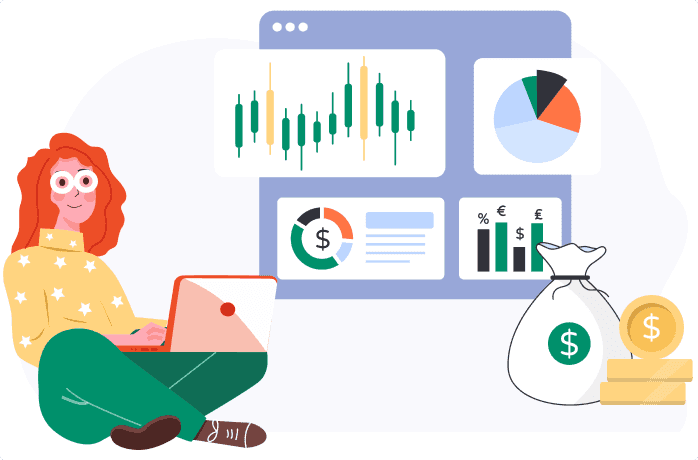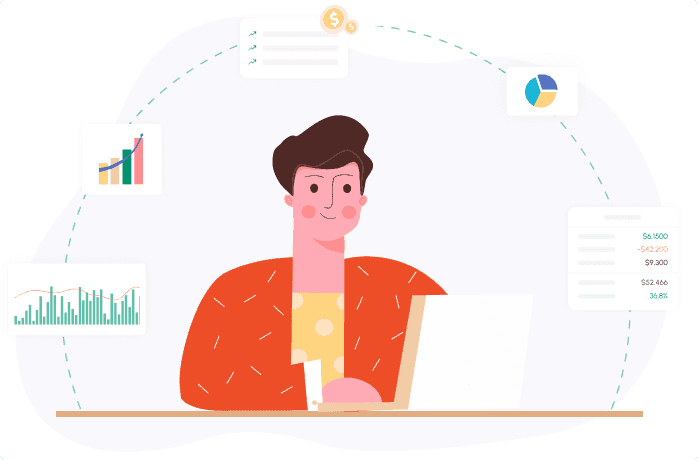Examples of Sales Forecasting For Your Business Growth

Sales forecasting isn’t just for large enterprises: each enterprise can derive a lot from these insights.
Implementing forecasting methods will benefit your business regardless of whether you run a small or mid-sized business.
You might have thought that your startup or small business will not benefit from forecasting in the future, but allow us to persuade you that it is essential for you to do forecasting for your sales.
Introduction to Sales Forecasting
What is a sales forecast?
Sales forecasting is a tool for predicting future sales based on historical data, market trends, and other factors. It estimates a business's income over a specified time period, ranging from one week to one year.
As an example, public enterprises frequently generate sales estimates for the upcoming quarter and year. Smaller firms can profit from short-term forecasts of up to one week.
Examples of sales forecasting include methods like historical data analysis and opportunity stage forecasting.
But why is sales forecasting so crucial?
Businesses can make informed decisions by anticipating periods of high demand or potential downturns. Accurate sales forecasts allow companies to:
- Hiring people during a sales rush
- Laying people off when weak sales are projected
- Prepare for sales fluctuations
- Adjust workforce needs
- Manage resources efficiently
Ultimately, a consistent sales forecast definition would be a process to estimate the sale of a product or service over a specified time.
Benefits of Accurate Sales Forecasting
Increase Your Chance of Hitting Sales Targets:
Forecasts make Reaching sales targets easier. One survey found that 97% of companies hit their goals when they had forecasts.
Why? Although no specific data was provided, it can be hypothesized that the sales team worked harder to hit the forecasted figures, and managers were able to allocate resources more effectively based on projections.
Sales forecasting examples from top-performing companies show that clear targets, derived from accurate forecasts, create focus and drive within sales teams, leading to better performance.
Aid in Decision-Making:
Data-backed decisions are often sound and better help a business grow. Sales forecasts allow leaders to make pertinent decisions based on the potential sales of the company. Funding can be sought for slow sales periods or workers hired if there’s an influx of sales.
For example, you can seek funding during slow sales or hire workers when sales increase.
According to Pipedrive, businesses that use sales forecasting tools can make more strategic decisions on everything from inventory management to marketing investments, improving overall efficiency and reducing waste.
Strategic Planning:
Scenarios and strategic planning can be put in place when you run sales forecasts. You'll have the opportunity to correct potential sales slumps and find ways to better manage cash flow.
A well-constructed sales forecast example, like top-down or bottom-up, guides leadership in resource allocation during peak or slow periods. Gong.io highlights that historical data helps businesses prioritize high-value opportunities and focus efforts effectively.
Identify Industry Trends:
Sales forecasts can help you identify valuable trends in your industry. Has a specific product or service stopped performing well in the market? If so, you can spot this trend and funnel more money into advertising, adjust your product offerings, or discontinue the item if the market appetite has shifted away from it.
Recognizing past performance patterns helps companies stay ahead and adjust strategies. Multi-variable forecasting offers insights into shifting industry dynamics, ensuring agility.
Better Preparedness for the Future:
Forecasting helps businesses prepare for the future by developing contingency plans for growth or decline.
Though forecasts aren't 100% accurate, 'what if' scenarios help companies adapt to market changes such as economic shifts or supply chain issues, and tools like Pipedrive enhance accuracy and flexibility.
Utilizing forecasting means being better prepared for the future. It's unlikely that your forecast will be 100% accurate, but it can help you develop contingency plans for periods of growing or declining sales.
Real-Life Sales Forecasting Examples
Forecasting sales can be done using multiple methods, but many companies are using software to run the calculations.
Below are some standard sales forecasting techniques with examples:
1. Historical Data Forecast
Sales software commonly applies this method by assigning probabilities to deals at different funnel stages. By analyzing trends like holiday spikes, companies can forecast similar sales increases, such as a typical 20% rise during the holidays.
2. Opportunity Stage Probability Forecast
This method, which is standard in sales software, assigns a probability to deals at various stages in the funnel. By multiplying this probability by deal size, businesses estimate potential revenue. On a side note, if there is an 80% chance of eventually making a $10,000 deal, the prediction is $8,000.
3. Sales Cycle Forecast
It clarifies when businesses will sign specific contracts and expect certain revenues. For example, an organization that signs up two $5,000 deals monthly will bring in $10,000.
4. Bottom-up Forecast
This method gathers sales estimates from individual reps and combines them to form the company forecast. It’s collaborative and adjusts based on real-time data. Accuracy improves when salespeople understand their prospects and customer behavior.
5. Top-down Sales Forecast
This method starts with company-wide revenue goals and breaks down targets by departments or regions. For example, a $1 million target might be split equally between two areas, ensuring alignment with strategic goals.
6. Multi-variable Forecast
This approach combines historical data, economic trends, and competitor analysis for a comprehensive forecast. For example, it evaluates the impact of a competitor’s price change alongside seasonal trends and market conditions.
Creating an Effective Sales Forecast Template
Creating a sales forecast template can help simplify the forecasting process. Spreadsheets and software tools are available that can help you create templates.
Whether using spreadsheets or cash flow forecasting software, a straightforward template can simplify sales forecasting.
When building your template, ensure it includes the following:
- The specific period you’re forecasting (weekly, monthly, yearly)
- What you’re forecasting
- Your goals
- The time periods you’re covering
- Your most important KPIs
- Any relevant external factors that could influence sales
- Historical data for baselining future projections
Using an example of a sales forecast from your industry or a sales projection example as a guideline, you can customize your template better to meet your business needs.
Best Practices for Strategic Sales Forecasting
Regarding sales forecasting, it’s essential to follow the best practices to ensure they’re reliable and accurate.
Use Historical Data
If you have an established business, use historical data to create your forecasts. If you have a new business or haven’t implemented analytics or other forms of data tracking, now is the time to start.
Understanding your past will help you understand where you’re headed. For example, if your sales data from the last three years shows a consistent increase of 10% each quarter, you can use that trend to project future sales. Additionally, analyzing historical data by product category may reveal that certain items perform better during specific seasons; for instance, winter clothing typically sees a spike in sales during the fall months.
While historical data isn't always an accurate prediction of the future, it can serve as a solid foundation for your forecasts.
For instance, if your historical data indicates that a particular marketing campaign led to a 30% increase in sales during its run last year, you can anticipate a similar outcome when planning future campaigns, while also adjusting for any changes in market conditions or competition.
Use a Simple Model
Using several sales forecasting models is a natural desire, but it is better to refrain from it. Hence, build a basic model and scale its importance over time.
The fewer variables you have to keep track of, the better. Why? Because it will be more easy to:
- Achieve your sales goals
- Secure approval from leadership on your sales forecast
If you start with a simple model, you can build on it slowly.
For instance, consider starting with a simple model that forecasts sales based on historical data and one key variable, such as the number of leads generated. As you gain confidence and experience, you can gradually introduce additional variables like seasonal trends, customer demographics, or marketing campaign performance.
For example, once you establish a baseline using lead generation data, you might analyze how sales typically increase by a certain percentage during peak seasons, allowing you to refine your forecasts further.
Don’t Forget Seasonality
If your business has high and low seasons, don’t forget to incorporate that into your forecasting model.
If your forecast is linear, you will lose some accuracy and reliability due to seasonality or other factors.
For example, Revvana highlights how businesses in industries such as retail or hospitality often see predictable seasonal sales fluctuations.
Neglecting these fluctuations can severely impact forecast accuracy—plan for seasonality to handle both peak and off-seasons efficiently.
Consider Market Trends and Your Competitors
Sales are affected by more than internal factors, like your sales team. Many external factors and variables are market-related and will affect your sales and, ultimately, your forecasts.
Let’s say you have two new and trendy products, another a steady staple. These should have separate segments because their growth trajectories differ. If a competitor lowers prices, it will affect your sales.
Competition is another consideration. If you have a competitor that has similar offerings and decides to lower their price, this will undoubtedly affect your sales.
Keeping a pulse on the market is important, as you can take these factors into account and create more accurate sales forecasts.
Monitoring external factors is essential for accurate sales forecasting. Consider the following:
- Track market trends to assess external sales influences
- Monitor competitor pricing and new product launches
- Adjust forecasts based on competitor analysis
- Include customer behavior and demand trends
- Factor in economic shifts like inflation or recession
- Stay updated on industry innovations and technology changes
Consider “What If” Scenarios
They are creating “what if” scenarios that allow you to examine your business from different perspectives and gain new insights. These scenarios can help you build sales forecasts.
For example, Pipedrive uses models of different scenarios to anticipate potential risks or opportunities. By preparing for the unexpected—such as changes in the economy or consumer preferences—you can create more robust, flexible sales forecasts that better prepare your business for various outcomes.
Tools and Software for Sales Forecasting
Many businesses now use sales forecasting software to streamline the process and improve accuracy. These tools connect with your financial information and generate forecasts in real-time, which helps prevent human error. These platforms offer robust insights into your sales trends, allowing you to adjust forecasts as needed.
Some examples of popular forecasting tools include:
- Pipedrive: Pipedrive’s sales forecasting software allows you to track deals at every stage of the sales funnel, making it easy to estimate future revenue.
- Gong.io: Gong.io applies AI-powered insights that help sales teams be more accurate forecasters from real-time data.
- Revvana: Revvana provides advanced sales forecasting solutions by combining historical data, sales cycles, and multiple variables for comprehensive forecasts.
These tools make forecasting more accessible and accurate for every business.
Conclusion
All types of businesses, even small enterprises, can forecast and benefit from it. Precise forecasts provide information on future revenue, which lets you make more informed decisions, allocate resources, and design long-term plans. Whether simple or multi-variable models, using these methods helps you stay ahead of the curve, manage risk, and grab opportunity. With the right tools, forecasting becomes a roadmap to business growth and success.
Get better profits by learning to monitor your revenues and expenses effectively and efficiently.

Current Liabilities: Meaning, Examples, and How to Calculate Them
Read more

What Is a Finance Charge? A Simple Explanation You’ll Actually Use
Read more

Current Assets Explained: Meaning, Types, and How They Work
Read more

Cash Flow Forecasting Template
Read more

Your Guide To Financial Metrics And KPIs
Read more

10 Cash Management Trends for 2026
Read more
FAQ
Trusted by thousands of business owners
Start Free Trial Now